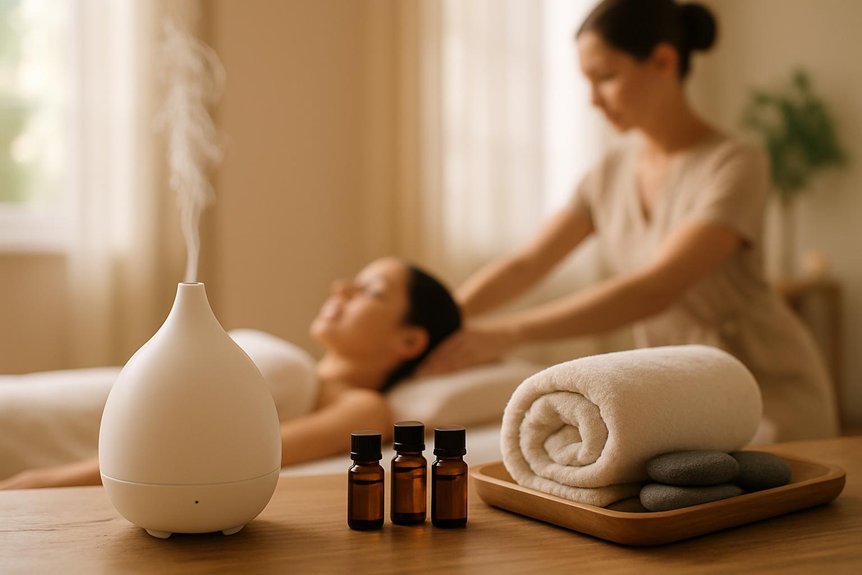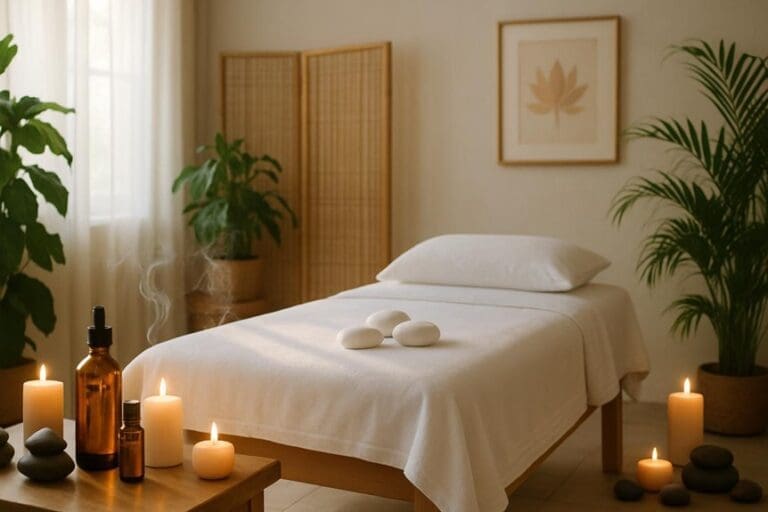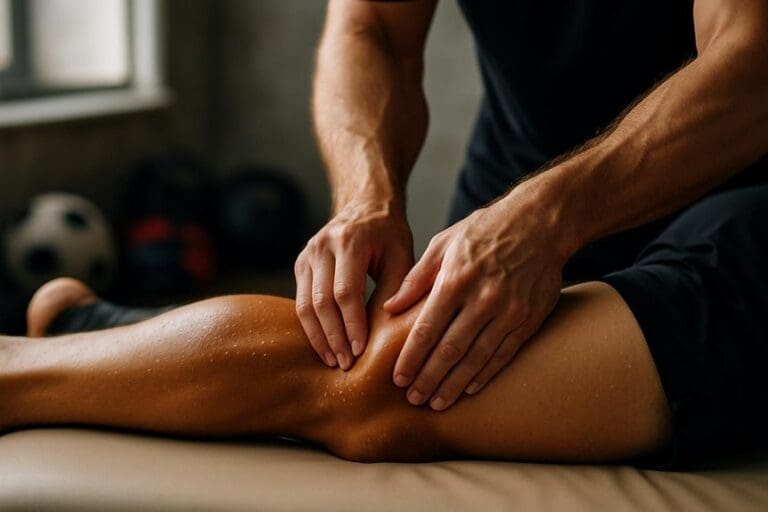Aromatherapy treatment does not always include massage. Essential oils may be applied through various methods such as inhalation, diffusers, baths, or compresses, each carefully selected based on therapeutic goals and client sensitivities. Safety protocols, including proper dilution and patch testing, are integral to every method. While massage can enhance absorption and relaxation, alternatives are equally effective when tailored to individual needs. The distinct techniques and benefits of each approach are outlined in greater detail below.
Understanding Aromatherapy: Core Principles and Methods

How does aromatherapy harness the power of natural plant extracts to promote well-being? Aromatherapy is founded on the use of essential oils—concentrated aromatic compounds derived from flowers, leaves, and other botanical sources. These extracts interact with the body through inhalation or topical application, engaging the olfactory system and skin receptors. Scientific studies suggest that specific essential oils may influence mood, relaxation, and perceived stress by modulating neurotransmitter activity. At Spa & Massage, therapists select oils based on individual client needs, always prioritizing safety and sensitivity. Dilution with carrier oils guarantees skin compatibility, and contraindications are carefully considered to prevent adverse reactions. This evidence-based approach allows for a tailored experience, fostering physical and emotional intimacy in a secure, professional environment. If you’re seeking to relax and heal with aromatherapy, massage is often recommended as an effective method to enhance its benefits.
Types of Aromatherapy Treatments Offered in Wellness Clinics
A comprehensive scope of aromatherapy treatments can be found in professional wellness clinics, each designed to address specific physical and emotional needs through the therapeutic application of essential oils.
Treatments may include inhalation therapy, where essential oils are diffused into the air for mindful breathing, and topical applications, where diluted oils are gently applied to the skin in targeted areas.
At Spa & Massage, expert therapists carefully select oils based on each guest’s preferences, sensitivities, and wellness goals, ensuring a personalised and safe experience.
Additionally, some aromatherapy treatments focus on relaxation, while others are tailored for stress relief, mental clarity, or skin nourishment.
Each approach is rooted in evidence-based protocols, with careful attention paid to the purity and dilution of essential oils for ideal safety and benefit.
The Role of Massage in Aromatherapy Sessions
Within aromatherapy treatments, massage serves as a primary method for delivering the therapeutic benefits of essential oils. The application of gentle, rhythmic strokes enables essential oils to penetrate the skin, supporting absorption into the bloodstream for systemic effects.
At Spa & Massage clinics, therapists carefully select oils based on each client’s preferences and needs, ensuring compatibility with skin types and health conditions.
Evidence suggests that combining massage with aromatherapy enhances relaxation, reduces muscle tension, and supports emotional well-being more effectively than either approach alone.
Therapists observe professional safety standards, conducting patch tests when appropriate and providing aftercare guidance.
This approach allows clients to experience both the tactile intimacy of massage and the subtle, lasting effects of aromatic plant essences, curated for comfort and holistic wellness.
Alternatives to Massage in Aromatherapy Practices
While massage remains the most direct method for delivering aromatherapy’s therapeutic benefits, several alternative practices also utilise essential oils to promote well-being.
Inhalation is widely recognised as an effective approach, where essential oils are diffused into the air, allowing gentle absorption through the respiratory system.
Baths with diluted essential oils offer another soothing alternative, providing both topical and aromatic exposure in a private setting.
Compresses—cloths soaked in water with a few drops of essential oil—can be applied to specific areas for targeted relief.
At Spa & Massage, therapists educate clients on safe home use, emphasising appropriate dilution and avoidance of skin irritation or sensitisation.
Each alternative approach is tailored, mindful of individual sensitivities, ensuring an intimate, nurturing environment while maximising therapeutic outcomes.
Benefits of Combining Aromatherapy With Massage
Combining aromatherapy with massage may provide synergistic benefits, including enhanced relaxation and a greater sense of calm.
Evidence suggests that this integrated approach can improve circulation, support natural healing processes, and promote deeper emotional wellbeing.
At Spa & Massage, therapists select essential oils and techniques that are tailored to client needs, ensuring both safety and ideal therapeutic outcomes.
Enhanced Relaxation and Calm
As the therapeutic benefits of massage are well established, the integration of aromatherapy further enhances relaxation and calm by leveraging the physiological effects of essential oils on the nervous system.
In Spa & Massage clinics, carefully selected essential oils are blended to suit individual preferences and sensitivities, with therapists trained to recognize suitable combinations for stress reduction.
Evidence suggests that certain essential oils, such as lavender and chamomile, can modulate the parasympathetic nervous response, reducing anxiety and promoting a sense of safety and comfort.
During treatment, the gentle diffusion or topical application of these oils heightens sensory engagement, deepening the state of relaxation.
This holistic synergy fosters an environment where clients may experience profound calm, supporting emotional balance and a deeper connection to their own sense of wellbeing.
Improved Circulation and Healing
When aromatherapy is integrated with professional massage, physiological processes that support circulation and healing are especially enhanced.
At Spa & Massage, therapists use carefully selected essential oils, which, when applied with targeted massage techniques, encourage vasodilation and improve blood flow to tissues. This increased circulation facilitates the delivery of oxygen and nutrients, supporting cellular repair and the removal of metabolic waste.
As a result, the body’s innate healing mechanisms are activated more efficiently.
For clients seeking both nurturing touch and tangible health benefits, this approach offers a dual advantage: the therapeutic properties of essential oils complement the mechanical effects of massage.
Therapists at Spa & Massage always tailor oil selection and massage intensity to individual needs, ensuring safety and *excellent* support for each person’s unique circulatory and healing requirements.
Deeper Emotional Wellbeing
While scientific research continues to explore the full scope of aromatherapy’s psychological effects, clinical experience at Spa & Massage consistently demonstrates that integrating essential oils with therapeutic massage can considerably promote emotional equilibrium.
The carefully selected essential oils used by Spa & Massage therapists are known for their mood-enhancing properties, such as lavender for relaxation or bergamot for uplifting the spirit. Paired with therapeutic touch, these oils engage both olfactory and tactile senses, encouraging a calming response from the nervous system.
This combination has been observed to help reduce symptoms of stress, anxiety, and emotional fatigue in clients. All essential oils are blended with carrier oils to ensure skin safety and maximum absorption, supporting a gentle yet profound shift towards deeper emotional wellbeing and overall tranquility.
How Spa & Massage Tailors Aromatherapy Experiences
Recognising that each individual presents unique wellness needs and preferences, Spa & Massage employs a personalised approach to aromatherapy treatments. Therapists conduct thorough consultations, identifying specific health goals, sensitivities, and scent preferences before recommending essential oils.
In practice, oils are carefully selected for their evidence-backed therapeutic properties, such as lavender for relaxation or eucalyptus for respiratory relief. Application methods—whether through gentle massage, inhalation, or targeted compresses—are chosen to suit the client’s comfort and objectives.
Safety remains paramount; therapists adhere to strict dilution guidelines and perform patch testing for those with sensitivities. This meticulous, client-focused process ensures that each aromatherapy experience aligns with professional standards while nurturing a sense of intimacy, trust, and individualised care throughout every session at Spa & Massage.
Choosing the Right Aromatherapy Treatment for Your Needs
How can individuals guarantee their aromatherapy massage is both effective and safe?
At Spa & Massage, clients are encouraged to communicate their preferences, sensitivities, and health concerns during the initial consultation.
Experienced therapists select essential oils based on evidence-backed properties and tailor them to suit specific needs—whether targeting relaxation, muscle tension, or emotional balance.
Strict protocols are followed to make sure oils are used at concentrations proven safe for skin application, minimizing the risk of irritation or allergic reactions.
The treatment environment is designed for comfort and tranquility, supporting a sense of intimacy and trust.
Conclusion
Aromatherapy, like a gentle mist infusing the air, offers its benefits through more than massage alone—diffusers, inhalation, and topical applications all play a role. At Spa & Massage, therapists carefully assess each client’s needs, ensuring essential oils are delivered safely and effectively. Whether paired with the soothing touch of massage or experienced through other precise methods, aromatherapy’s restorative qualities remain accessible, inviting individuals to discover a tailored path toward greater wellbeing and relaxation under expert guidance.



